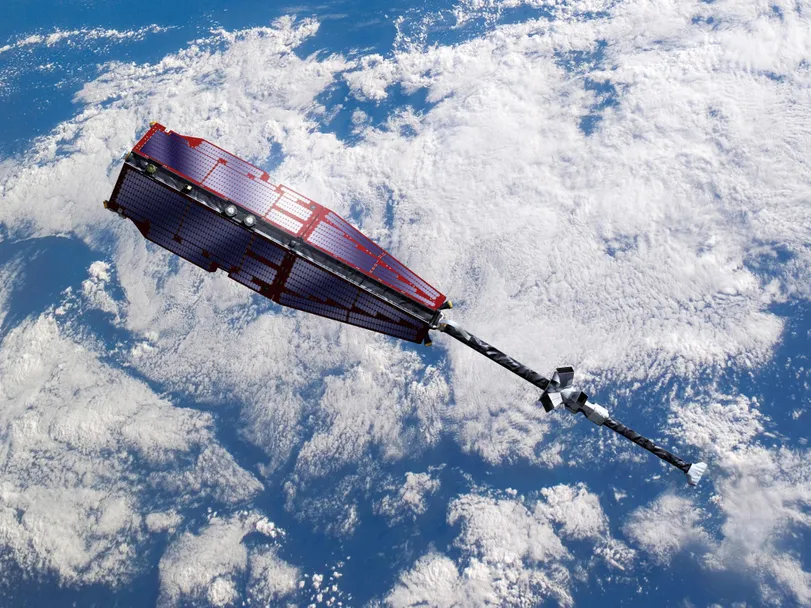Pressure is mounting at the European Space Agency’s mission control center. A European Space Agency (ESA) satellite avoids a mysterious piece of space junk that was spotted just hours before a potential collision.
This means that a vital step in the spacecraft’s journey to a safer skies must be quickly rescheduled as the intense solar activity associated with the intensification of the solar cycle distorts Earth’s atmosphere and threatens to derail the satellite…
swarm? of mistakes?
not exactly – swarm In fact, the function of ESA is to detect Earth’s magnetic field puzzles. It consists of three satellites, A, B and C – affectionately known as Alpha, Bravo and Charlie.
what happened?
A small piece of man-made trash orbiting our planet – the so-called space junk – On June 30, 16:00 CET (10:00 EST), she was seen speeding towards Alpha. A possible collision from the track was predicted just eight hours later, after midnight. The chance of a crash was high enough that the Alfa needed to get off the road quickly.
constellation swarm. The swarm is the European Space Agency’s first constellation of Earth observation satellites. Its mission is to explore one of the most mysterious aspects of our planet: the magnetic field. Credit: ESA-P. Charles, 2013
There is trash in space?
a lot of it. Fragments of old rockets and satellites, as well as small debris left over from past collisions and chaotic avalanches, orbit our planet. Any small piece can cause serious damage to a satellite, while larger pieces can destroy the satellite and create large amounts of new debris.
Was this the first time this had happened?
At that day? Can. Ever? No way. Each ESA satellite has to perform an average of two evasive maneuvers per year – and this does not include all the alerts they receive that do not ultimately require an evasion.

The image of the Sentinel-1A solar array in the second panel shows before and after the millimeter particle impact. The diameter of the damaged area is about 40 cm, which corresponds to this structure with an impact fracture of less than 5 mm. Credit ESA
So what’s the big deal?
Elusive action – the so-called “Collision avoidance maneuver– It requires a lot of planning. You have to check that you are not putting the satellite into a new orbit which puts it at risk of more collisions, and you have to figure out how to get it back into its original orbit using as little fuel as possible and losing as little knowledge as possible. .
The European Space Agency’s Office of Space Debris analyzes data from the US Space Monitoring Network and alerts the ESA’s flight control and flight dynamics teams to the possibility of a collision, usually more than 24 hours before the debris approaches the satellite.
In this case, we were only notified eight hours in advance.
Even worse, the alert meant that Team Swarm was now racing all of a sudden with a two-hour savings. Another maneuver was planned just a few hours after the potential collision and had to be called off to give Alfa enough time to move away from the wreckage. This maneuver was also very time sensitive and had to be completely re-planned, recalculated and executed within a day.
What was the other maneuver?
Climb Alpha and Charlie to escape the wrath of the sun. Both satellites had to perform 25 maneuvers over 10 weeks to reach their new, higher orbits. One of the Alpha maneuvers was planned for a few hours after the possible collision.

Solar Cycle 25 forecast, NOAA, July 2022. The number of sunspots on the Sun’s surface is dwindling and dwindling over the approximately 11-year solar cycle. Our star is currently entering a very active period of its 25th solar cycle. credit: NOAA
Wait, the sun is killing the satellites?
It gets into a very active part of our daysolar cycle‘ Immediately. This activity increases the density of Earth’s upper atmosphere. Satellites pass through “thicker” air, which slows them down, and requires a limited amount of fuel on board to stay in orbit. Alpha and Charlie have moved to a less dense part of the atmosphere where they can stay in orbit and hopefully collect scientific data and extend missions for many more years!
What would have happened had it not been for this maneuver?
Alpha would have drifted toward Charlie, and the orbits of the two satellites would have crossed soon enough. This would have made Swarm’s overall mission “cross,” limiting her ability to conduct science until another maneuver brings Alpha and Charlie together.
Is the swarm okay now?
Team Swarm achieved reaction time in the Olympic sprint event. Working with the Flight Dynamics team at ESA’s Mission Control Center, they planned and executed the evasive action in just four hours, and re-planned and executed the other maneuver within 24 hours.
Alpha is now safe from hitting that piece of wreckage and has completed her ascent to safer skies alongside Charlie. But there’s a lot of debris out there, and it appears with little warning that it could threaten a satellite.

The European Space Agency (ESA) Laser Measurement Station in Tenerife points its green laser into the sky. Creditworthiness: ESA
How can teams keep up with these failure alerts?
With new technology, more sustainable behavior and taking responsibility for space waste very seriously. ESA is building new technology More debris tracking, it evolves New sports equipment This helps you plan, execute and act on the rapidly growing number of evasive maneuvers Governing rules This limits the amount of new garbage that we and other satellite operators add to the problem. We are even working on capturing larger pieces of debris and using them to remove them from the trackspace claw“.












































